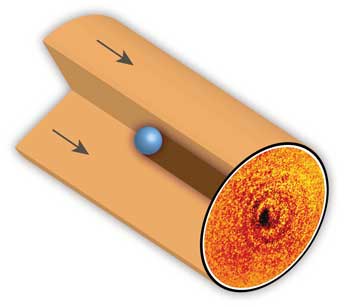
Portrait of a single atom
The shadow of a single atom was photographed for the first time using a superhigh-resolution microscope, a discovery that could help scientists confirm their understanding of atomic physics and advance quantum computing.
“We have reached the extreme limit of microscopy; you cannot see anything smaller than an atom using visible light,” said professor Dave Kielpinski of Griffith University’s Centre for Quantum Dynamics. “We wanted to investigate how few atoms are required to cast a shadow, and we proved it takes just one.”
Holding an atom still long enough to take its photo is not new technology; the atom is isolated within a chamber and held in free space by electrical forces.
Kielpinski and colleagues trapped single atomic ytterbium ions and exposed them to a specific frequency of light. Under the light, the atom’s shadow was cast onto a detector, and a digital camera captured the image. At the heart of their five-year-long achievement is a superhigh-resolution microscope that made the shadow dark enough to see.

An illustration of the single atom’s shadow. The discovery could be useful for quantum computing.
“By using the ultrahigh-res microscope, we were able to concentrate the image down to a smaller area than has been achieved before, creating a darker image which is easier to see,” Kielpinski said.
The precision involved in the process is almost beyond imagining.
“If we change the frequency of the light we shine on the atom by just one part in a billion, the image can no longer be seen,” he said.
The implications of these findings are far-reaching, said team member Dr. Erik Streed.
“Such experiments help confirm our understanding of atomic physics and may be useful for quantum computing,” he said. There are also potential follow-on benefits for biomicroscopy.
“Because we are able to predict how dark a single atom should be, as in how much light it should absorb in forming a shadow, we can measure if the microscope is achieving the maximum contrast allowed by physics,” Streed said. “This is important if you want to look at very small and fragile biological samples such as DNA strands, where exposure to too much UV light or x-rays will harm the material.”
It is now possible to predict just how much light will be needed to observe processes within cells under the microscope without crossing the threshold and destroying them, he said.
“In the end, a little bit of light just might be enough to get the job done.”
The results appeared in Nature Communications (doi: 10.1038/ncomms1944).
Published: September 2012